Journal article by Kumar Biswajit Debnath
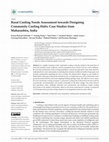
Sustainability, 2021
In a rapidly warming world, sustainable cooling is directly related to the protection of fresh an... more In a rapidly warming world, sustainable cooling is directly related to the protection of fresh and nutritious food, medicines, and the population from extreme heat for work conditions, the economic productivity of the working population, and income generation. This study aimed to understand how rural communities are meeting their nutrition, livelihood, health, living space, and mobility requirements regarding the role of cooling. We selected three villages as case studies in Maharashtra, India and conducted household surveys, in-depth interviews of key informants, focus group discussions (FGDs), and social mapping building typology study. The objective was to assess the rural community cooling to propose a community cooling hub (CCH) framework that could be economically, environmentally, and socially sustainable for the three villages. Our study showed that agriculture, dairy, buildings (domestic and commercial), and healthcare require cooling intervention in the studied communities. Based on the needs assessment for cooling, we proposed a CCH framework to provide cooling solutions in an integrated system for rural contexts.
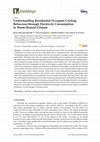
Buildings, 2020
According to the India Energy Security Scenario 2047, the number of residential air conditioner (... more According to the India Energy Security Scenario 2047, the number of residential air conditioner (A/C) units may increase seven-fold by 2037 as compared to 2017. Also, the related energy consumption might increase four times in the next two decades, according to India’s National Cooling Action Plan. Therefore, the study of occupant cooling behaviour is essential to reduce and manage the significant electricity demand, helping to formulate and implement climate-specific cooling policies, and to adopt low-energy and low-cost technologies at mass-market scale. The study aims to analyse residential electricity consumption in order to investigate occupant behaviour, especially for thermal comfort by using space cooling and mechanical ventilation technologies. Among the five climate zones in India, this study focuses on the occupant behaviour in a warm-humid climate using Auroville as a case study, where climate analysis of the past 30 years demonstrated progression towards unprecedented warmer weather in the last five years. In this study, electricity consumption data from 18 households (flats) were monitored for seven months (November 2018–June 2019). The study also elaborated the limitations faced while monitoring and proposed a data filling methodology to create a complete daily profile for analysing occupant behaviour through electricity consumption. The results of the data-driven approach demonstrated the characteristics and complexities in occupant behaviour and insight on the operation of different technologies to attain thermal comfort in residential buildings in an increasingly warming climate.

Renewable and Sustainable Energy Reviews, May 2018
Energy planning models (EPMs) play an indispensable role in policy formulation and energy sector ... more Energy planning models (EPMs) play an indispensable role in policy formulation and energy sector development. The forecasting of energy demand and supply is at the heart of an EPM. Different forecasting methods, from statistical to machine learning have been applied in the past. The selection of a forecasting method is mostly based on data availability and the objectives of the tool and planning exercise. We present a systematic and critical review of forecasting methods used in 483 EPMs. The methods were analyzed for forecasting accuracy; applicability for temporal and spatial predictions; and relevance to planning and policy objectives. Fifty different forecasting methods were identified. Artificial neural network (ANN) is the most widely used method, which is applied in 40% of the reviewed EPMs. The other popular methods, in descending order, are: support vector machine (SVM), autoregressive integrated moving average (ARIMA), fuzzy logic (FL), linear regression (LR), genetic algorithm (GA), particle swarm optimization (PSO), grey prediction (GM) and autoregressive moving average (ARMA). Regarding accuracy, computational intelligence (CI) methods demonstrate better performance than that of the statistical ones, in particular for parameters with greater variability in the source data. Moreever, hybrid methods yield better accuracy than that of the stand-alone ones. Statistical methods are used for only short and medium range, while CI methods are preferable for all temporal forecasting ranges (short, medium and long). Based on objective, most EPMs focused on energy demand and load forecasting. In terms, geographical coverage, the highest number of EPMs were developed in China. However, collectively, more models were established for the developed countries than the developing ones. Findings would benefit researchers and professionals in gaining an appreciation of the forecasting methods and enable them to select appropriate method(s) to meet their needs.
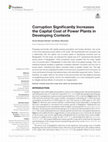
Frontiers in Energy Research, Mar 8, 2018
Emerging economies with rapidly growing population and energy demand, own some of the most expens... more Emerging economies with rapidly growing population and energy demand, own some of the most expensive power plants in the world. We hypothesized that corruption has a relationship with the capital cost of power plants in developing countries such as Bangladesh. For this study, we analyzed the capital cost of 61 operational and planned power plants in Bangladesh. Initial comparison study revealed that the mean capital cost of a power plant in Bangladesh is twice than that of the global average. Then, the statistical analysis revealed a significant correlation between corruption and the cost of power plants, indicating that higher corruption leads to greater capital cost. The high up-front cost can be a significant burden on the economy, at present and in the future, as most are financed through international loans with extended repayment terms. There is, therefore, an urgent need for the review of the procurement and due diligence process of establishing power plants, and for the implementation of a more transparent system to mitigate adverse effects of corruption on megaprojects.

Nature Energy, Mar 6, 2018
Energy planning models (EPMs) support multi-criteria assessments of the impact of energy policies... more Energy planning models (EPMs) support multi-criteria assessments of the impact of energy policies on the economy and environment. Most EPMs originated in developed countries and are primarily aimed at reducing greenhouse gas emissions while enhancing energy security. In contrast, most, if not all, developing countries are predominantly concerned with increasing energy access. Here, we review thirty-four widely used EPMs to investigate their applicability to developing countries and find an absence of consideration of the objectives, challenges, and nuances of the developing context. Key deficiencies arise from the lack of deliberation of the low energy demand resulting from lack of access and availability of supply. Other inadequacies include the lack of consideration of socio-economic nuances such as the prevalence of corruption and resulting cost inflation, the methods for adequately addressing the shortcomings in data quality, availability and adequacy, and the effects of climate change. We argue for further research on characterization and modelling of suppressed demand, climate change impacts, and socio-political feedback in developing countries, and the development of contextual EPMs.
Conference paper by Kumar Biswajit Debnath
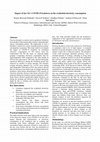
Building Simulation 2021, 2021
Extreme disruptive scenarios such as pandemic lockdown force people to alter regular daily routin... more Extreme disruptive scenarios such as pandemic lockdown force people to alter regular daily routines, impacting their energy consumption pattern. The implication of such a disruptive scenario for a more extended period on energy consumption is uncertain. This study aimed to investigate the impact of COVID-19 lockdown on residential electricity consumption in 100 houses from the southwestern UK. For the study, we analysed highly granular (1-minutely) electricity consumption data for April-September 2020 compared to the same months in 2019 for the same houses. Our study showed statistically significant differences during the lockdown period (the analysed six months) in energy demand. The minutely average electricity demand was 1.4-10% lower during April-September 2020 than in 2019. Our analysis showed that not all houses had similar type of changes during the lockdown. Some houses demonstrated a 38% increase in electricity demand, whereas some houses showed a 54% reduction during the lockdown period compared to 2019. Some houses showed significantly higher electricity use during the morning and afternoon than in 2019, which might be due to working and schooling from homes during the lockdown.
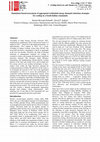
Proceedings of the 5th IBPSA-England Conference on Building Simulation and Optimization (Virtual), Loughborough, UK: 21-22 September 2020. Eds. Bianca Howard, Argyris Oraiopoulos, and Eleonora Brembilla., 2020
According to India Energy Security Scenario 2047, residential air conditioners (A/Cs) will increa... more According to India Energy Security Scenario 2047, residential air conditioners (A/Cs) will increase from 21.8 million in 2017-about 8% of the Indian households-to approximately 154.4 million in 2037. As a result, according to Indian Cooling Action Plan (ICAP), the associated electricity consumption is likely to quadruple in the next two decades. Therefore, the study of demand reduction or management strategies for cooling is essential to reduce and manage the projected significant electricity demand. The strategies might influence formulating and implementing climate-specific cooling policies at the state and country level, and to adopt new low-energy and low-cost cooling technologies at mass-market scale. Under the high electricity demand for cooling projections of India, the objective of this study is to investigate the increase in A/C use on the aggregated consumption as well as to assess the performance of residential cooling demand management strategy (load shifting) on the reduction of peak electricity demand load of part of a community (Auroville) in Southern India. The analysis showed that the elevated ownership of A/C might increase average daily electricity demand ~6.6 times than that of the base case scenario of using all-electric fans for attaining thermal comfort. The mixed-mode uses of A/Cs and fans created a demand management opportunity through load shifting which demonstrated ~46% reduction (for 15 min shift of 50% household A/C use) potential for aggregated electricity peak loads.
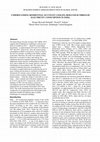
International Conference on Building Energy Demand Reduction in Global South 2019, 2019
The India Energy Security Scenario 2047 (IESS, 2047) suggests that residential air conditioners w... more The India Energy Security Scenario 2047 (IESS, 2047) suggests that residential air conditioners will increase from 21.8 million in 2017-about 8% of the Indian households-to approximately 68.9 and 154.4 million in 2027 and 2037, respectively. Also, the related energy consumption is likely to increase by a factor of four in the next two decades, according to the Indian cooling action plan. Therefore, the study of occupant cooling behaviour is essential to reduce and manage this significant electricity demand, helping to formulate and implement climate-specific cooling policies at the state level, and to adopt new low energy and low-cost cooling technologies at mass-market scale. The study aims to examine residential electricity consumption to investigate occupant behaviour by analysing the use of space cooling and mechanical ventilation technologies. Among the five climate zones in India, this study focuses on the occupant cooling behaviour in a warm-humid climate-using the village of Auroville as a case study-where summer and wintertime temperature can be 25-35°C and 20-30°C, respectively, with relative humidity 70-90%. For the analysis, electricity consumption data from 18 households (flats) are monitored for seven months (November 2018-June 2019). The results demonstrate the characteristics and complexities in occupant behaviour and insight on the operation schedule for different space cooling technologies in residential buildings.
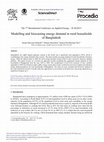
Energy Procedia, Aug 28, 2015
Bangladesh, the eighth largest populous country in the world, has a significant rural population ... more Bangladesh, the eighth largest populous country in the world, has a significant rural population (70%), which is contributing to the energy demand of the country. The major portion in energy demand of rural households is biomass energy. With the improvement in GDP the rural energy demand would switch to more electricity intensive demand pathway. This paper focuses on a bottom up approach towards modelling the aggregated energy demand of rural households of Bangladesh form the year 2010 to 2050. The combination of four level scenarios of four variables (population, GDP electrification index, public energy conservation index) would forecast lowest, highest and optimum energy demand pathways for rural households of Bangladesh. The study not only considers the electricity demand of the rural household, but also it would render the opportunity to concentrate at the detail user end energy demands (e.g. liquid fuel, biomass etc.).
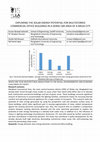
PLEA 2015 Proceeding , Jun 2016
Motijheel Commercial Area, the main central business district (CBD) of Dhaka city, Bangladesh has... more Motijheel Commercial Area, the main central business district (CBD) of Dhaka city, Bangladesh has already been found through many studies to cause urban heat island (UHI) effect due to its densely built multistoried commercial buildings and lack of green areas. These buildings consume significant amount of electricity to accommodate the lighting facilities, mechanical means for ensuring thermal comfort and operating electrical appliances for a huge number of occupants. This research seeks the potential of solar energy generation by using the prospective roof and elevation surface areas of these buildings, which takes significant part in causing augmentation of mean radiant temperature against the existing electricity consumption rate. Also, this research aims to establish a comparative analysis between existing electricity demand and the solar electricity generated to explore the potential of solar energy harvesting in a densely built urban area. In addition to it, the influence of choice in lighting technology (incandescent, florescent, CFL and LED) would be further examined to see their contribution in electricity demand. This study may contribute in policy development for the already densely built high electricity demanding commercial urban areas into self-sustaining low electricity demanding urban zones.

AEI 2013: Building Solutions for Architectural Engineering , 2013
"In the recent times with the increase in the population, the number of retail shopping environme... more "In the recent times with the increase in the population, the number of retail shopping environments has increased significantly in Dhaka city. But these shopping environments are developing into high consumption areas of electricity resulting from artificially light design approach. In this study, it was found that the energy consumption is rising because of the minimal or no use of daylight and natural ventilation. A field-based case study was conducted to review the daylight inclusion in the design of retail shopping environments representing the historical periods of 1950-70, 1971-80, 1981-90, 1991-2000, 2001-2011. In this research, in addition to field work, parametric study was done to identify the effect of design factors/parameters relating to daylight. The main focus was to develop a causal relation between the parameters of the shopping environments to maximize the use of daylight. The parameters which were considered in this study were: width, height and depth of the shops; the depth of the corridor between two rows of shops; and the height and width of the light wells. All the parametric relations were derived to the width of the shop. Daylight level were measured and compared with the given level in the Bangladesh National Building Code (BNBC) code. It was found that shopping environments play an important role in energy consumption in urban areas and little or no utilization of daylight contribute to this energy demand. This is of particular significance in an environment where dwindling fossil sources of energy and an increasing energy demand created by positive economic growth pose a challenge for the building industry stake holders."
Just like every other country, Bangladesh has her own set of challenges and possibilities, one o... more Just like every other country, Bangladesh has her own set of challenges and possibilities, one of which is the power sector. The discourse of this study is a Cumulative Community Solar Power Plant (CCSPP). A power plant that will be community based. The paper also includes the calculations for exemplary situations, simulations and estimations of realistic applications, which will help to rationalize the prospects of the CCSPP.
With the rapid increase in population and therefore urbanization, the concept of CCSPP can help us to find alternate ways to generate more green sources for power.

Dhaka city has a around history of about 400 years, where trade and commerce played an important ... more Dhaka city has a around history of about 400 years, where trade and commerce played an important role. The retail shopping environments of Dhaka city evolved progressively over this time period. In the recent times with the increase in the population, the numbers of retail shopping environments have increased significantly. But these shopping environments are developing into high consumption areas of electricity as a result of introvert design approach. In this study, it is found that the energy consumption is rising because of the minimum or no use of natural daylight and ventilation.
A field based case study was conducted to review the daylight inclusion and the utilization of natural ventilation in the design of retail shopping environments representing the historical periods of 1950-70, 1971-80, 1981-90, 1991-2000, 2001-2011. In spite of the presence of retail shopping environments before 1950, the study was conducted from the period of 1950-70. The use of electricity in retail shopping environments of Dhaka was started from that time period. The energy consumption of the retail shopping environments representing the respective historical periods were analyzed and compared to find the relation of the daylight inclusion and the utilization of natural ventilation in the design with the energy consumption.

Proceeding of 4th International Conference on Environmental Aspects of Bangladesh" (ICEAB), in Fukuoka, JAPAN, 2013
"A good number of buildings are located very close to road junctions in Dhaka City. Due to poor s... more "A good number of buildings are located very close to road junctions in Dhaka City. Due to poor setback, building edges hinder visibility. Traffic noise travelling from a main road to a secondary road and vice versa, diffracts at building edges creating virtual images of noise source. This may cause confusion and lead to accidents. It is established that noise threatens human health. But it is not much explored how this unique phenomenon of sound diffraction at road junctions, as a side effect of noise pollution, may create confusion and cause accidents. From instrumental measurements and practical observations, this study identifies evidences of sound diffraction, virtual position of noise source and its effect on erroneous perception at road junctions. This paper suggests proper setbacks of buildings, appropriate geometry of building edge and suitable acoustical properties of finish materials to eliminate diffraction of sound at road junctions of "Dhaka city."

"Dhaka city is expanding day by day. With the increase in the population, the numbers of retail s... more "Dhaka city is expanding day by day. With the increase in the population, the numbers of retail shopping environments are increasing. But these shopping environments are developing into high consumption areas of electricity. From previous studies, it was found that the energy consumption is rising because of the minimum or no use of natural daylight and ventilation. Most of the shopping environments are using large amount of energy for artificial lighting and ventilation. All most all the recent developed shopping environments are introvert in design which is resulting in higher consumption of electricity. Some of the retail shopping environments are designed with atriums. All of them are enclosed. This study intends to investigate the influence of enclosed atriums in electricity consumptions of a retail shopping environment. For this study two different retail shopping environments were selected. These are Basundhara city and the Eastern Plaza. Basundhara City has a large atrium with a stained glass roof on it. On the other hand Eastern Plaza has no atrium. In the study the electricity consumption is being analyzed thoroughly. The impact of atrium on cooling load and lighting condition is being analyzed. The energy needed for lighting and artificial ventilation of the two shopping environments is going to be compared to project the influence of enclosed atriums on the energy consumption. The comparison shows the adverse influence of the enclosed atriums on the indoor air temperature, which contributes in the augmentation of the cooling load. Thus influencing the energy consumption. "
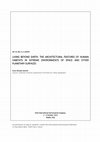
Earth is the only habitable planet for life form. Life started to develop on earth approximately ... more Earth is the only habitable planet for life form. Life started to develop on earth approximately 4.5 billion years ago. But human beings appeared on earth about 2.5 million years ago. For a good future of mankind it is important to ensure the food safety; energy safety; safety from global warming, sea level rise, another ice age, asteroids and other space component which can create partial or full mass destruction on earth. According to known facts we are alone in the solar system. But there are planets which can be developed into habitable human colonies.
Living outside the earth is a challenge to human kind whether in space or in a distant planet. In micro or less gravity environment we are neither adopted nor comfortable for many issues like temperature, air pressure, dryness, radiation etc. To make those habitats livable, an architect can contribute by designing an efficient and comfortable functional space to accommodate the researches. This study will help to understand the architectural attributes of International Space Station and other ongoing different design concepts of human habitation modules or colonies which will contribute in determining the architectural features which should be considered while designing the outer space or other planetary surface human habitats. The main focus of this study is the architectural features of the interior space which influences the psycho-physiological well-being of the researchers.
In terms of human centered design logic, in long duration space missions, colors, light and interior decor must have among their purposes: psycho-physiological well-being, orientation, and supportiveness for all activities. It is therefore necessary to recall, through stimulating elements, the “normality” in confined artificial environments. Physical and psychological conditions can be improved featuring variety and natural variations occurring in time according to the principle of natural design. The architects can organize these confined spaces in an effective space. For these reason the need for their involvement stemmed from the push to extend space mission durations and address the needs of astronauts including but beyond minimum survival needs.
In the future the space will be human kind’s main destination for energy, habitation, tourism, industries etc. These features will help to increase the efficiency of the astronauts and decrease the effect of long term space missions. It is therefore necessary to design a better environment with the use of colour, light, art and activity spaces which will create an adaptive space within a confined artificial environment.
Conference Presentations by Kumar Biswajit Debnath

Motijheel Commercial Area, the main central business district (CBD) of Dhaka city, Bangladesh has... more Motijheel Commercial Area, the main central business district (CBD) of Dhaka city, Bangladesh has already been found through many studies to cause urban heat island (UHI) effect due to its densely built multistoried commercial buildings and lack of green areas. These buildings consume significant amount of electricity to accommodate the lighting facilities, mechanical means for ensuring thermal comfort and operating electrical appliances for a huge number of occupants. This research seeks the potential of solar energy generation by using the prospective roof and elevation surface areas of these buildings, which takes significant part in causing augmentation of mean radiant temperature against the existing electricity consumption rate. Also, this research aims to establish a comparative analysis between existing electricity demand and the solar electricity generated to explore the potential of solar energy harvesting in a densely built urban area. In addition to it, the influence of choice in lighting technology (incandescent, florescent, CFL and LED) would be further examined to see their contribution in electricity demand. This study may contribute in policy development for the already densely built high electricity demanding commercial urban areas into self-sustaining low electricity demanding urban zones.
Papers by Kumar Biswajit Debnath

Motijheel Commercial Area, the main central business district (CBD) of Dhaka city, Bangladesh has... more Motijheel Commercial Area, the main central business district (CBD) of Dhaka city, Bangladesh has already been found through many studies to cause urban heat island (UHI) effect due to its densely built multistoried commercial buildings and lack of green areas. These buildings consume significant amount of electricity to accommodate the lighting facilities, mechanical means for ensuring thermal comfort and operating electrical appliances for a huge number of occupants. This research seeks the potential of solar energy generation by using the prospective roof and elevation surface areas of these buildings, which takes significant part in causing augmentation of mean radiant temperature against the existing electricity consumption rate. Also, this research aims to establish a comparative analysis between existing electricity demand and the solar electricity generated to explore the potential of solar energy harvesting in a densely built urban area. In addition to it, the influence of choice in lighting technology (incandescent, florescent, CFL and LED) would be further examined to see their contribution in electricity demand. This study may contribute in policy development for the already densely built high electricity demanding commercial urban areas into self-sustaining low electricity demanding urban zones.











Uploads
Journal article by Kumar Biswajit Debnath
Conference paper by Kumar Biswajit Debnath
With the rapid increase in population and therefore urbanization, the concept of CCSPP can help us to find alternate ways to generate more green sources for power.
A field based case study was conducted to review the daylight inclusion and the utilization of natural ventilation in the design of retail shopping environments representing the historical periods of 1950-70, 1971-80, 1981-90, 1991-2000, 2001-2011. In spite of the presence of retail shopping environments before 1950, the study was conducted from the period of 1950-70. The use of electricity in retail shopping environments of Dhaka was started from that time period. The energy consumption of the retail shopping environments representing the respective historical periods were analyzed and compared to find the relation of the daylight inclusion and the utilization of natural ventilation in the design with the energy consumption.
Living outside the earth is a challenge to human kind whether in space or in a distant planet. In micro or less gravity environment we are neither adopted nor comfortable for many issues like temperature, air pressure, dryness, radiation etc. To make those habitats livable, an architect can contribute by designing an efficient and comfortable functional space to accommodate the researches. This study will help to understand the architectural attributes of International Space Station and other ongoing different design concepts of human habitation modules or colonies which will contribute in determining the architectural features which should be considered while designing the outer space or other planetary surface human habitats. The main focus of this study is the architectural features of the interior space which influences the psycho-physiological well-being of the researchers.
In terms of human centered design logic, in long duration space missions, colors, light and interior decor must have among their purposes: psycho-physiological well-being, orientation, and supportiveness for all activities. It is therefore necessary to recall, through stimulating elements, the “normality” in confined artificial environments. Physical and psychological conditions can be improved featuring variety and natural variations occurring in time according to the principle of natural design. The architects can organize these confined spaces in an effective space. For these reason the need for their involvement stemmed from the push to extend space mission durations and address the needs of astronauts including but beyond minimum survival needs.
In the future the space will be human kind’s main destination for energy, habitation, tourism, industries etc. These features will help to increase the efficiency of the astronauts and decrease the effect of long term space missions. It is therefore necessary to design a better environment with the use of colour, light, art and activity spaces which will create an adaptive space within a confined artificial environment.
Conference Presentations by Kumar Biswajit Debnath
Papers by Kumar Biswajit Debnath
With the rapid increase in population and therefore urbanization, the concept of CCSPP can help us to find alternate ways to generate more green sources for power.
A field based case study was conducted to review the daylight inclusion and the utilization of natural ventilation in the design of retail shopping environments representing the historical periods of 1950-70, 1971-80, 1981-90, 1991-2000, 2001-2011. In spite of the presence of retail shopping environments before 1950, the study was conducted from the period of 1950-70. The use of electricity in retail shopping environments of Dhaka was started from that time period. The energy consumption of the retail shopping environments representing the respective historical periods were analyzed and compared to find the relation of the daylight inclusion and the utilization of natural ventilation in the design with the energy consumption.
Living outside the earth is a challenge to human kind whether in space or in a distant planet. In micro or less gravity environment we are neither adopted nor comfortable for many issues like temperature, air pressure, dryness, radiation etc. To make those habitats livable, an architect can contribute by designing an efficient and comfortable functional space to accommodate the researches. This study will help to understand the architectural attributes of International Space Station and other ongoing different design concepts of human habitation modules or colonies which will contribute in determining the architectural features which should be considered while designing the outer space or other planetary surface human habitats. The main focus of this study is the architectural features of the interior space which influences the psycho-physiological well-being of the researchers.
In terms of human centered design logic, in long duration space missions, colors, light and interior decor must have among their purposes: psycho-physiological well-being, orientation, and supportiveness for all activities. It is therefore necessary to recall, through stimulating elements, the “normality” in confined artificial environments. Physical and psychological conditions can be improved featuring variety and natural variations occurring in time according to the principle of natural design. The architects can organize these confined spaces in an effective space. For these reason the need for their involvement stemmed from the push to extend space mission durations and address the needs of astronauts including but beyond minimum survival needs.
In the future the space will be human kind’s main destination for energy, habitation, tourism, industries etc. These features will help to increase the efficiency of the astronauts and decrease the effect of long term space missions. It is therefore necessary to design a better environment with the use of colour, light, art and activity spaces which will create an adaptive space within a confined artificial environment.